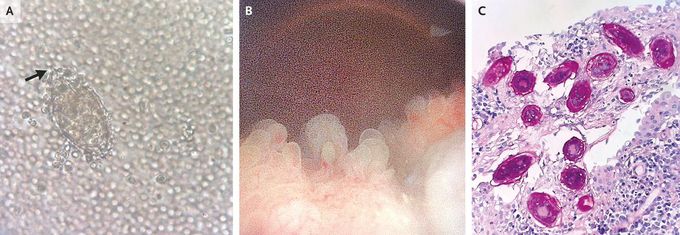


Urinary Schistosomiasis
A 13-year-old boy from Mali was referred to the pediatric urology clinic with a 3-month history of gross hematuria. He reported no fevers, flank pain, or dysuria. A physical examination was normal. Laboratory studies showed normal kidney function, an absolute eosinophil count of 2660 per cubic millimeter (reference range, 40 to 200), and an IgE level of 3544 IU per milliliter (reference range, 0 to 200). A urinalysis showed hematuria and pyuria, and a urine culture was negative. On microscopic examination of the urine, there were oval-shaped parasite eggs with a terminal spine, a finding consistent with Schistosoma haematobium (Panel A, arrow; 0 to 1 eggs per high-powered field). Subsequent cystoscopy showed polypoid masses extruding into the bladder lumen (Panel B). Histopathological examination of a bladder-biopsy specimen showed numerous schistosome eggs, acute and chronic papillary and polypoid cystitis, and no dysplasia (Panel C). A serum circulating anodic antigen test for schistosoma was positive. A diagnosis of urinary schistosomiasis due to S. haematobium was made. Treatment with praziquantel was administered. Two weeks after initiation of treatment, the patient’s gross hematuria resolved. One month after initiation of treatment, urine studies showed no microscopic hematuria or schistosome eggs.

